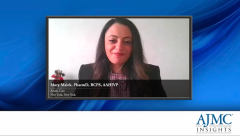
Managing HIV During COVID-19
Episodes in this series

Best practices for initiating rapid anti-retroviral therapy and monitoring patients who are on HIV treatment during the COVID-19 pandemic.
Transcript:
Moti Ramgopal, MD, FACP, FIDSA: The rapid ART [antiretroviral therapy] initiation in the present COVID-19 [coronavirus disease 2019] era has changed significantly. I do a lot of clinical trials. Most of my patients who are recently diagnosed can go into clinical trial or start their medications very quickly. Rapid ART initiation doesn't necessarily have to be the same date of diagnosis, but we try to encourage patients to be seen as quickly as possible. Within the first visit, I still continue to do a physical visit.
I will not do a telehealth visit for a patient who was recently diagnosed. I will initiate ART as much as close to what it was before COVID-19. I try to keep that conversation as clean as possible. Even before COVID-19, we would engage a patient early, obtain the labs, and start treatment—we're pretty much doing the same thing. All the employees in offices wear masks. Everyone is, every patient [who] comes in the office [must] be screened, temperature checks, making sure that they've not been exposed.
We do a brief history uptake with fever and respiratory complaints. And if you find that the patient is a very low risk for being COVID-19 positive, we still sit with them. We have them in the room. If we find that they are probably recently exposed to COVID-19 or at high risk of, we'd probably postpone starting them on treatment until we can actually see them in the office. There may be a delay in rapid initiation as a result of these challenges we are facing, but I learned the delay is not usually much more than 2 weeks.
The adverse events story, it's changed in a way whereby we use telemedicine now. Within a week to 2 weeks, the patient will call us and we'll call them. The challenge I face in my community, as I mentioned earlier, the income in my community is very low—a lot of patients do not have cell phones. And even those who do have cell phones, and the elderly patients, have difficulty connecting with the apps on the phone, with the telemedicine visit.
Many times, I'm on the phone, “Can I see you? Can you see me?” And “how are you feeling,” and we get this broken discussion. And sometimes it's not a continuous story. We don't get to do vital signs. We have to rely on the physical appearance of a patient with the televisit. We really do stress at least get in a visit very frequently. And especially when you now start a new medication regimen, patients have concerns. Is the medication working? I'm taking medicine. I have no adverse effects. I feel fine. How do I know the medication is working? And I guess this is when you must have those telemedicine visits. And then, when you get labs again, you can review those with the patient in a physical visit because it's incredibly difficult, when you think of it, to really administer health care to an HIV population with telemedicine. I have been doing it, but it’s still a challenge.
It's a challenge because not only is it a learning curve from my end, it's a learning curve for the patient. I don't think you can communicate empathy. You can communicate care and that social support you need to offer patients through a telemedicine visit.
Newsletter
Stay ahead of policy, cost, and value—subscribe to AJMC for expert insights at the intersection of clinical care and health economics.




































